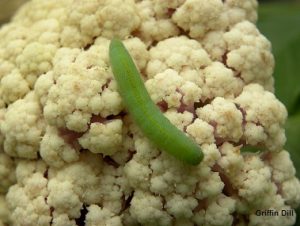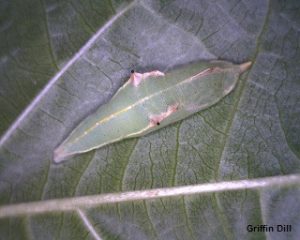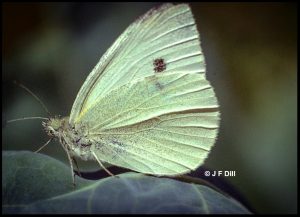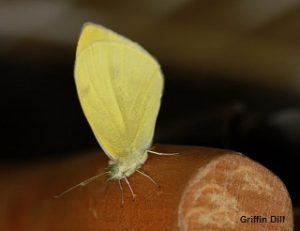Imported Cabbageworm
Pest Management Fact Sheet #5006
James F. Dill, Pest Management Specialist
Clay A. Kirby, Insect Diagnostician
Charles D. Armstrong, Cranberry Professional & Staff Entomologist
For information about UMaine Extension programs and resources, visit extension.umaine.edu.
Find more of our publications and books at extension.umaine.edu/publications/.
Introduction
Imported cabbageworm (Pieris rapae) larvae prefer to feed on cabbage, cauliflower, broccoli, Brussels sprouts, turnips, radishes, kale, lettuce and weeds of the mustard family. In fact, this pest is one of the most damaging and destructive enemies of these plants. The caterpillars chew irregular holes in the leaves and usually eat their way into cabbage heads from the bottom. In addition to the feeding damage, the insects’ frass will stain cauliflower.
Description & Biology
The first sign of imported cabbageworm is often the 1½” butterfly which has yellowish wing undersides but is otherwise white. This stage of the insect emerges early in the spring. The females fly during daylight hours looking for suitable plants on which to lay their eggs. The yellowish, elongated eggs, are laid singly on the underside of leaves.
In 5 to 7 days, the eggs hatch to become velvety green caterpillars which will grow to 1½” long. They have a thin yellowish-orange stripe down the middle of the back. It is common for high larval populations in July and August to damage plants so severely that they die or become unmarketable.
When fully grown, the larva forms a greenish-brown pupa (chrysalis) which can often be found hanging from the bottoms of leaves or other protected areas. Ten days later, the second generation of butterflies emerge, continuing the cycle. There may also be a third generation in Maine. Adults may be seen almost anytime during the summer.
- Imported Cabbageworm larva
- Imported Cabbageworm pupa
- Cabbage White butterfly (Pieris rapae) (male) (adult stage of the Imported Cabbageworm) (the wing undersides are yellowish)
- Another example of a Cabbage White butterfly with the yellow color of its wing undersides readily apparent
Management
Controlling weeds around the garden, especially plants of the mustard family, should help decrease the numbers of this pest. Destroying and removing the remains of plants in the fall, as well as fall tillage, reduces the number of over-wintering pupae. Hand-picking the larvae may be labor intensive but can significantly cut the numbers and keep damage down. Early Globe, Red Acre, and Round Dutch cabbage have shown some resistance to cabbageworm.
B.t. (Bacillus thuringiensis), an organic insecticide derived from a bacterium and sold as Dipel®, Bactur®, Sok-Bt® or Thuricide®, is a management method. B.t. is less effective under cooler conditions. Other options include spinosad, insecticidal soap, Sevin® (carbaryl) and malathion. The smaller the caterpillars are, the easier they are to kill. Insecticides should be applied in late afternoon or early evening to minimize bee exposure.
When Using Pesticides
ALWAYS FOLLOW LABEL DIRECTIONS!
Pest Management Unit
Cooperative Extension Diagnostic and Research Laboratory
17 Godfrey Drive, Orono, ME 04473
1.800.287.0279 (in Maine)
Information in this publication is provided purely for educational purposes. No responsibility is assumed for any problems associated with the use of products or services mentioned. No endorsement of products or companies is intended, nor is criticism of unnamed products or companies implied.
© 2016, 2018, 2020, 2023
Call 800.287.0274 (in Maine), or 207.581.3188, for information on publications and program offerings from University of Maine Cooperative Extension, or visit extension.umaine.edu.
In complying with the letter and spirit of applicable laws and pursuing its own goals of diversity, the University of Maine System does not discriminate on the grounds of race, color, religion, sex, sexual orientation, transgender status, gender, gender identity or expression, ethnicity, national origin, citizenship status, familial status, ancestry, age, disability physical or mental, genetic information, or veterans or military status in employment, education, and all other programs and activities. The University provides reasonable accommodations to qualified individuals with disabilities upon request. The following person has been designated to handle inquiries regarding non-discrimination policies: Director of Equal Opportunity, 101 Boudreau Hall, University of Maine, Orono, ME 04469-5754, 207.581.1226, TTY 711 (Maine Relay System).





